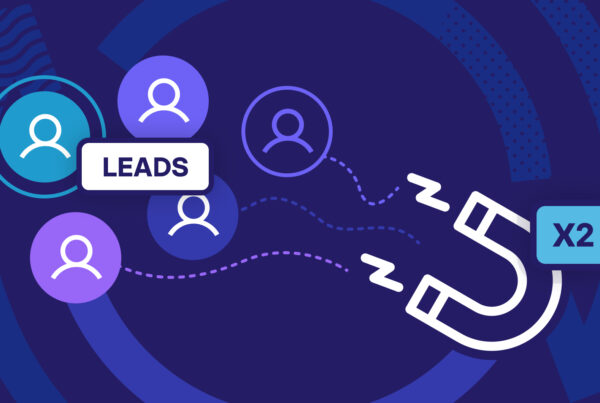Last year, I spent a lot of time experimenting with and implementing lead generation strategies for a B2B financial software company. It had its challenges, but I learned some invaluable techniques on how to drive more product demos.
Below are five tips that I found useful, and that I hope will enable you to generate more leads for your software service.
#1 Reduce time from visit-to-demo
When someone decides your software might be right for them, they want to see it – now.
Instead of playing email ping pong to schedule a demo, only to find that timezones and busy schedules mean that the demo has to be scheduled two weeks from now, use automation to reduce your ‘time to demo’.
GoCardless ran an A/B test where they replaced ‘request a demo’ with ‘watch a demo now’. Instead of taking leads to a page where they scheduled a demo, GoCardless tested taking leads to a 10-minute video demo of the software.

Now, I get that this is a ballsy experiment. A pre-recorded demo makes it harder to address specific objections and it may not feel as tailored. However, the data speaks for itself. For GoCardless, the pre-recorded demo resulted in a 114% improvement in their conversion rate.

One piece of advice I would add is that you should always start off by doing manual demos. That way you will understand the common objections your leads have and will be better prepared to put a good pre-recorded demo together.
Of course, if your clients are Fortune 500 companies you may need to alter this approach, perhaps by allowing them to schedule a ‘one-to-one call’ after they’ve watched the pre-recorded demo.
#2 Upgrade your lead capture form
Most B2B software companies use the generic web forms provided by Salesforce, Marketo, or whichever CRM/automation service they’re using.
While convenient, these forms are designed to be generic. They’re not designed to drive conversions, and are likely costing you leads. As such, it’s better to use something like Leadformly which allows you to quickly build lead generation forms that have been optimised for specific purposes – like driving product demos.

Your form is the last step in your lead generation process, and it has a significant amount of leverage. If you increased your form’s conversion rate from 2% to 4%, you’ve doubled the effectiveness of EVERY marketing and lead generation campaign that is driving leads to your website.
Forms may seem like a simple piece in your marketing machine – but they’re arguably one of the most important parts of your funnel to get right.
They’re also very easy to get wrong. In fact, Expedia lost $12 million per year by adding ONE field (company name). A study by Clicktale also found that asking for phone numbers can make up to 10x as many people abandon your form. The moral of the story is don’t gamble with forms – either pay a good UX design/conversion optimisation agency to design them, or use a tool like Leadformly.
#3 Get your product demo process right
Some software companies lose as many 50% of their leads due to the challenges of arranging and conducting online demos. Inevitably, you’ll have come across potential leads that…
- Due to company policy had to use their own Webex or GoToMeeting account.
- Had a poor Internet or audio connection.
- Forgot to add a calendar notification.
- Had a previous meeting that overran.
- Lost the meeting login link/pin code.
- Due to company policy couldn’t install any required browser plugins.
- Etc.
The reality is that some of these problems are unsolvable from your end. The best that you can do is ensure that you are never the problem, and then if there is a problem you have backup plans.
Here are a few ideas that I’ve found useful:
- Always ensure you are using the fastest and most stable broadband you can find. If you’re in the field a lot, get a high-speed portable WIFI device.
- Use marketing automation (or your web conferencing software) to automatically send meeting reminders via email and SMS one hour and ten minutes before every meeting. Include all of the necessary meeting links in these notifications, and remind them to go somewhere quiet and with a good Internet connection.
- Identify company policy issues when the demo is scheduled (not five minutes before the call). On your demo confirmation page mention something like “The scheduled demo will take place on Webex. If you’d prefer to use different software, please let us know here”.
Ultimately, you should be aiming for 100% of your scheduled demos to show up and be successful in the first attempt.
#4 Use whitepapers and ebooks to drive top of the funnel leads
Almost every B2B software client / project I’ve worked on, the best way to increase demo leads at the top of the funnel was through whitepapers, ebooks, and other free information products.
If you’re receiving a reasonable amount of traffic to your website, but are only converting a handful of visitors into leads, experiment with offering something valuable to leads to capture their email address.
You can then create a nurturing ‘drip campaign’ to gradually educate them on your service and bring them to a point where they’re ready to arrange a product demo.
#5 Experiment with one-to-many demos
I recently demo’d Intercom as a service to use for one of our ventures. To see whether it was a good fit for our company, I attended one of their weekly webinar demos. At first I thought this was a clever way of scaling demos without losing the personal touch.

The webinar went like this: Someone from Intercom did a personal introduction for a few minutes and then played a pre-recorded product demo that I believe lasted around 20 minutes. Afterwards, the host did live Q&A with a hundred or so people who were all watching the demo.
What I liked about this is that the live Q&A created a lot of social proof. I could clearly see that lots of other marketers were interested in this product, and I could see their objections being addressed. It was both operationally and psychologically impressive.
Over to you
Generating more product demos doesn’t require any radical thinking. It often just requires that you take down the barriers that are causing friction in your existing funnel.
While I hope the tips above provide some useful inspiration, the real lesson is to take a good hard look at your funnel and identify where the friction is for you. Then, experiment with different approaches to try and break down that friction.



